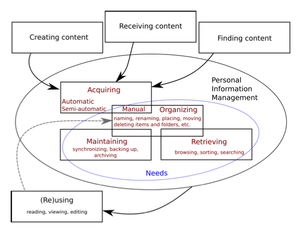PIM Framework - Matjaž Kljun
Matjaž Kljun
Main article can be found here
This framework is based on Bordman's and it includes four PIM sub-activities: acquiring, organizing, maintaining and retrieving. But it does not impose strict borders between PIM activities; rather it presumes that PIM activities overlap (not only happen interchangeably) as can be seen in Figure 3.
Its starting point is on different acquisition types which influences all other activities. It tries to frame for example such issues: an email that is automatically acquired and placed in our inbox which is for example our personal information collection; is deleting this email a keeping activity as we process new email messages and decide which we will keep or discard; or is deleting maintaining as we decide which information stays in the collection.
Acquisition
Acquisition can happen in three different ways: created, received and found. And each of these three sources can be acquired in several of these modes:
We have a total control over manually acquired information which can be (re)named and/or placed in information environment based on our decisions at the time we decide. On the other hand, automatically acquired information piles up in a predefined place while we do not have a control over its acquisition. While semi-automatically acquired information still needs our action to be acquired but some actions (like naming and placing, time of acquisition) can be done without our intervention (e.g automatically by an application). |
Examples:
- Created information
- Manually acquired: files we create and store, calendar notes we create in a certain place(s) in calendar, a stick-it note we write on put on a fridge, etc.
- Semi-automatically acquired: emails we write to others that are automatically placed in a sent folder after sending, emails we write to ourself (and know they will be placed in inbox), URLs we visit knowing they will be placed in a web browser’s history, etc.
- Received information
- Manually acquired: information received on removable media (CDs, DVDs, USB sticks) and manually placed in our PSI, documents we go to take from a colleague in the next office, etc.
- Semi-automatically acquired: emails we ask other people to send us with information we need (not knowing the time of acquisition), etc.
- Automatically acquired: received emails (and attachments) by others that we do not expect, started IM chats by others, calendar inputs by others in shared calendars, RSS feeds in a RSS client, voicemail etc.
- Found information (outside our PSI)
- Manually acquired: information such us files we find on the internet and manually place in PSI, cu out articles from newspapers and placed in e.g. folder, etc.
- Semi-automatically acquired: information such us downloaded files from the internet that are automatically placed in a predefined folder by web browser, files that P2P clients store in a predefined folder, automatically piled web bookmarks on the first level of a hierarchy, etc.
Organization
| Users change organizational structure (even if only a small part) also during other activities and that many such small changes incrementally (while thinking and rethinking about small portions of the existing schema) change structure and organization of PICs and PSI. As such information organization overlaps with all other activities as can be seen in Figure 3. |
Maintenance
| While organization deals with information items related to present ongoing tasks, maintenance is performed to support future (maybe unknown) needs and tasks. Maintaining means to manage the organizational schema in such a way that information related to past tasks, for which it is assessed that it will not be needed any more, is moved out of the way and the organizational schema is organized in a way to support future tasks while it still has to support ongoing tasks. Maintenance assures that organizational schema and existent information assist our needs and tasks in the longer run. Even here the border between maintenance and organization is not clear. During the maintenance users perform some organization activities (moving, deleting, creating folders and items, grouping, renaming, etc) and other activities such as archiving (moving out of sight either by moving information on removable media or hiding it deeper in a hierarchy), synchronizing and backing up. |
Consider two tasks:
- Lets get this desk organized as a sporadic activity in comparison to
- Daily organizing email inbox (moving, filing or deleting items).
Both tasks include organizing. But first one is about moving piles of papers from a desk to make place for new ones and to support other future PIM activities (in the long run). While the second task is more about supporting present PIM activities (not get overflown with email on a daily bases). Certainly it also supports future PIM but is more focused in the present.
Overlap and interchange
